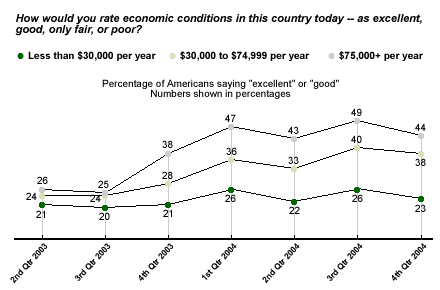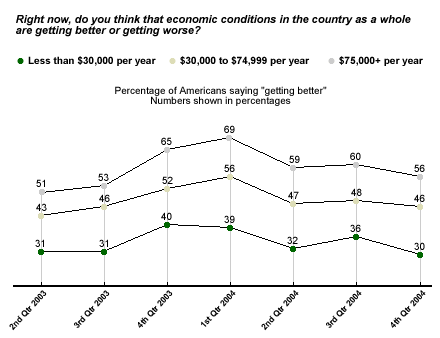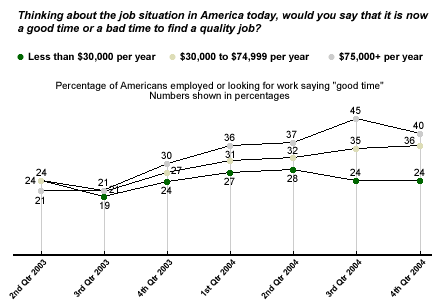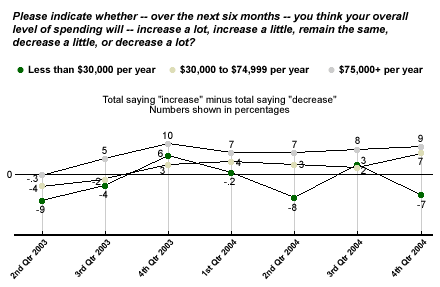Although Wal-Mart reported somewhat improved sales for last week, pervasive discounting suggests this will be another disappointing holiday season for many retailers. As I noted in September, this is particularly true for retailers serving middle- and lower-income consumers.
Now it's time to look past the holiday season and consider the consumer mood as we enter the first quarter of 2005. How optimistic are consumers about the coming year, and should retailers expect better things or simply more of the same? Gallup's quarterly data on consumer confidence, job market conditions, and spending intentions, broken down by consumer income levels*, provide a foundation on which to address these questions.
Consumers Rate Current Economic Conditions
Overall, 36% of consumers rate economic conditions in the fourth quarter of 2004 as "good" or "excellent" -- down from 39% in the third quarter, but about the same as the first quarter of this year, and substantially better than this time last year.
However, these consumer ratings continue to differ significantly by household income level. Forty-four percent of consumers earning $75,000 or more a year rate current economic conditions good or excellent. Today's rating is down five percentage points from 49% in the third quarter of 2004 among this relatively affluent segment, but nearly twice what it was during the second and third quarters of 2003.
Thirty-eight percent of middle-income consumers earning between $30,000 and $75,000 rate the economy as good or excellent -- about the same as last quarter. Twenty-four percent of consumers in this group provided positive ratings during the second and third quarters of 2003.
Twenty-three percent of consumers earning less than $30,000 a year rated current economic conditions as good or excellent this quarter. This is down three percentage points from last quarter and up only a couple of percentage points from the second- and third-quarter lows of 2003.

Consumers Rate Economic Direction
Overall consumer expectations for the future of the economy are down this quarter. Forty-five percent of consumers say economic conditions are "getting better," compared with 48% who said so during the third quarter. More importantly, this consumer rating is up only three to five percentage points from the second and third quarters of 2003.
Fifty-six percent of upper-income consumers say current economic conditions are getting better, down 4 percentage points from the third quarter and 13 percentage points from the first quarter. As with consumers overall, optimism among this group has risen only three to five percentage points since the middle of 2003.
Forty-six percent of middle-income consumers say things are getting better, a figure similar to both last quarter's and that of the third quarter of 2003.
Three in 10 lower-income consumers say economic conditions are improving, down six percentage points from last quarter and essentially the same as the second and third quarters of last year.

Consumers Rate Job Market
Four in 10 upper-income consumers who are either employed or looking for work say now is a good time to find a quality job. This percentage is down five percentage points from last quarter, but double what it was during the second and third quarters of 2003.
Thirty-six percent of middle-income consumers in the workforce say now is a good time to find a quality job -- essentially matching the 35% of last quarter. But this number is up 15 percentage points from 21% recorded in the third quarter of 2003.
About one in four lower-income workforce members think now is a good time to find a quality job, the same as last quarter but up only three to five points from the second and third quarters of 2003.

Consumer Spending Intentions
During the fourth quarter, the margin between the percentage of upper-income consumers planning to increase their spending level over the next six months and the percentage planning to decrease spending is nine percentage points. This is greater than the eight-point difference of last quarter and nearly twice the five-point difference of the third quarter of 2003. Upper-income spending intentions remain below the 10-point difference that existed this time last year.
The current difference between positive and negative spending intentions among middle-income consumers is seven percentage points, about three times the difference of last quarter and twice the difference of a year ago. Today's figures stand in sharp contrast to the negative spending intentions of middle-income consumers during the second and third quarters of 2003, when more of them expected to reduce, rather than increase, their spending over the next six months.
Despite today's positive spending intentions among upper- and middle-income consumers, though, lower-income consumers show negative spending intentions. More consumers earning less than $30,000 per year say they plan to decrease their spending over the next six months (30%) than say they plan to increase spending (23%), for a difference of -7 percentage points. This is slightly better than the -8-point difference from the second quarter of 2004, and the -9-point difference of the second quarter of 2003. But it is far below the positive 6-point difference of a year ago.

The Consumer Mood in Early 2005
Consumers rate current economic conditions better than they did a year ago, but they are much less optimistic about the direction of the economy, as their fourth quarter 2004 ratings resemble those of the second and third quarters of last year. In other words, Gallup's attitudinal data suggest another "soft patch" for the economy during the first quarter of 2005.
Not all consumers and retailers are likely to feel the impact of this slowdown in the same way. During the past year, differences in the way consumers of various income levels perceive the economy have diverged dramatically. Upper-income consumers have been more positive than their lower- and middle-income counterparts about current economic conditions, the economy's direction, and conditions in the job market. Our data suggest this will continue to be the case in early 2005, barring any unexpected plunges in the housing and/or equity markets.
In turn, middle-income consumers have been more positive than lower-income consumers in 2004. This quarter, middle-income consumers seem more optimistic about the job market than they have in the past and, not surprisingly, this has translated into a substantial increase in spending intentions. Assuming middle-income consumers continue to see improvements in the job market in early 2005 and gas prices do not surge again, this group may represent a new bright spot for the economy early next year.
Unfortunately, the outlook for lower-income consumers is not nearly so positive. The job market's slow recovery has had more severe consequences for this group. Demand for employees in this category remains relatively weak given the current level of economic growth -- a fact that may be due, at least in part, to job outsourcing. In addition, lower-income consumers are most severely affected by today's high gas prices. As a result, these consumers and the retailers who serve them are likely to continue suffering in early 2005.
Bottom Line
In my view, Gallup's economic data reflect the early effects of accelerated globalization on the U.S. economy. The divergence in consumer perceptions by income level manifests the way globalization has negatively affected lower-income households while doing just the opposite for upper-income groups.
But American consumers and the retailers that serve them have yet to experience all the effects of the growing interdependence of the world's economies. The Fed's recent interest rate hike is just one example. In 2005, growing concerns about foreign investment, the trade deficit, and the federal budget deficit will likely play a role not only in monetary policy-making, but also in the way consumers of all income levels perceive the state of the economy.
*Ratings of economic conditions and the economic direction are based on telephone interviews with 3,890 national adults, aged 18 and older, conducted Oct. 9-10, 11-14, Nov. 7-10, and Dec. 5-8, 2004. Ratings of the job market and spending intent are based on telephone interviews with 2,919 national adults, aged 18 and older, conducted Oct. 11-14, Nov. 7-10, and Dec. 5-8, 2004. For results based on respondents with household incomes below $30,000, one can say with 95% confidence that the margin of sampling error is ±4 percentage points. For results based on respondents with household incomes between $30,000 and $75,000 or $75,000 and above, one can say with 95% confidence that the margin of sampling error is ±3 percentage points. In addition to sampling error, question wording and practical difficulties in conducting surveys can introduce error or bias into the findings of public opinion polls.
